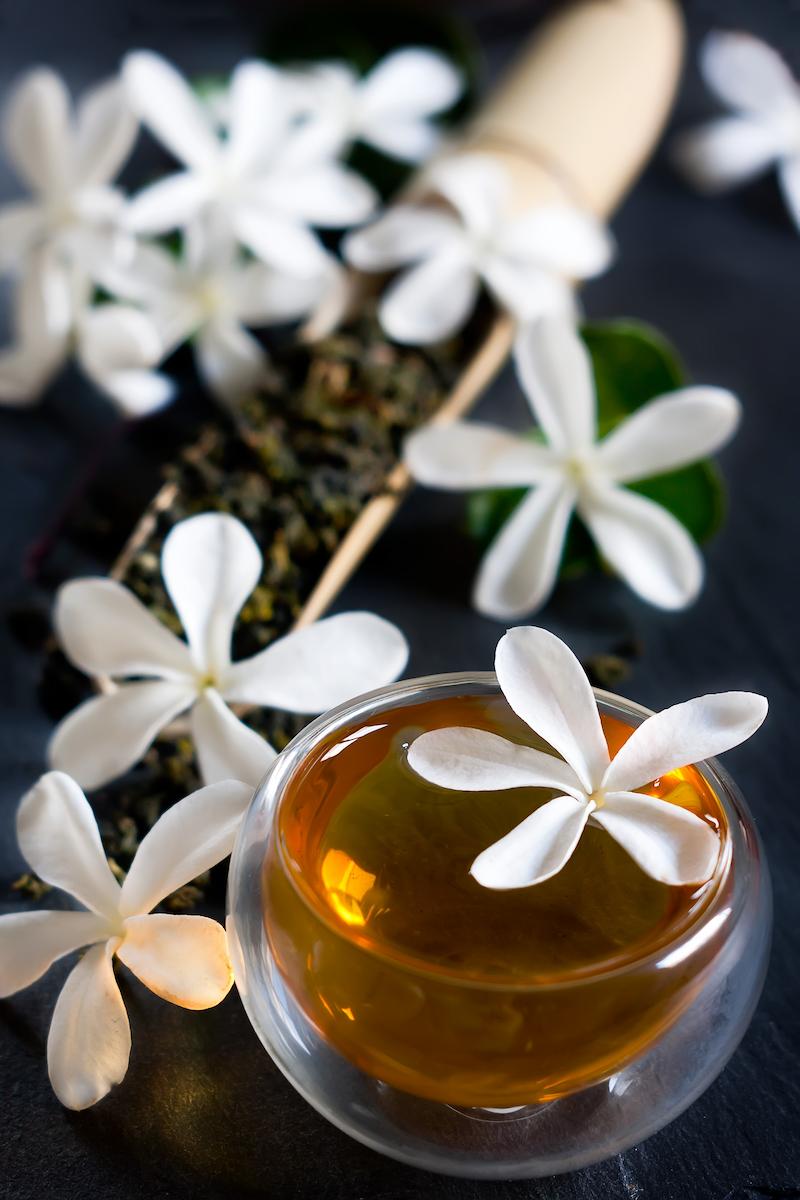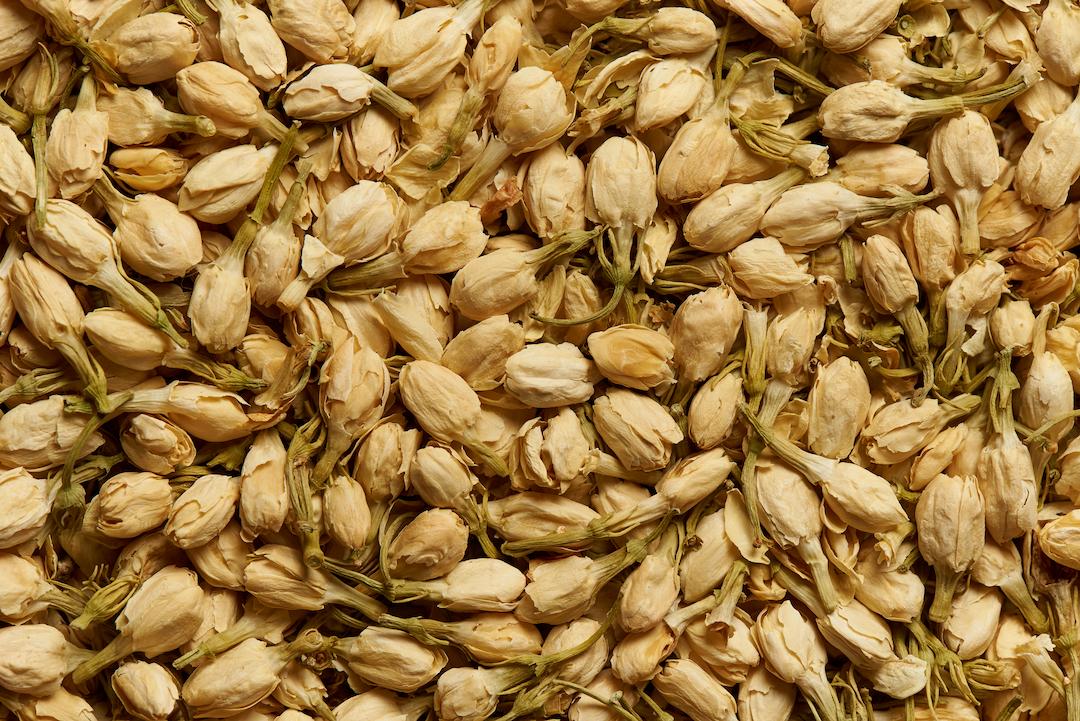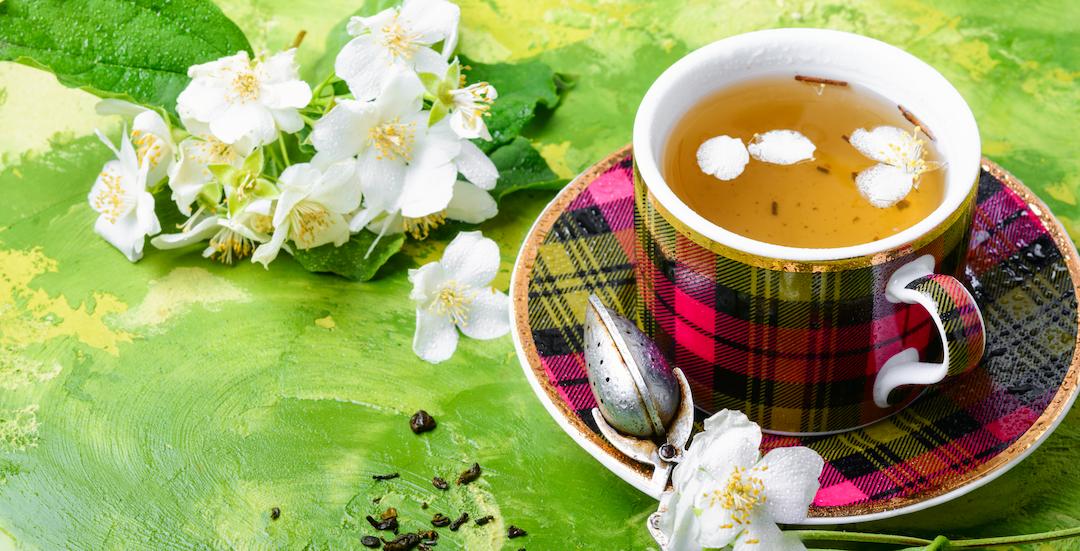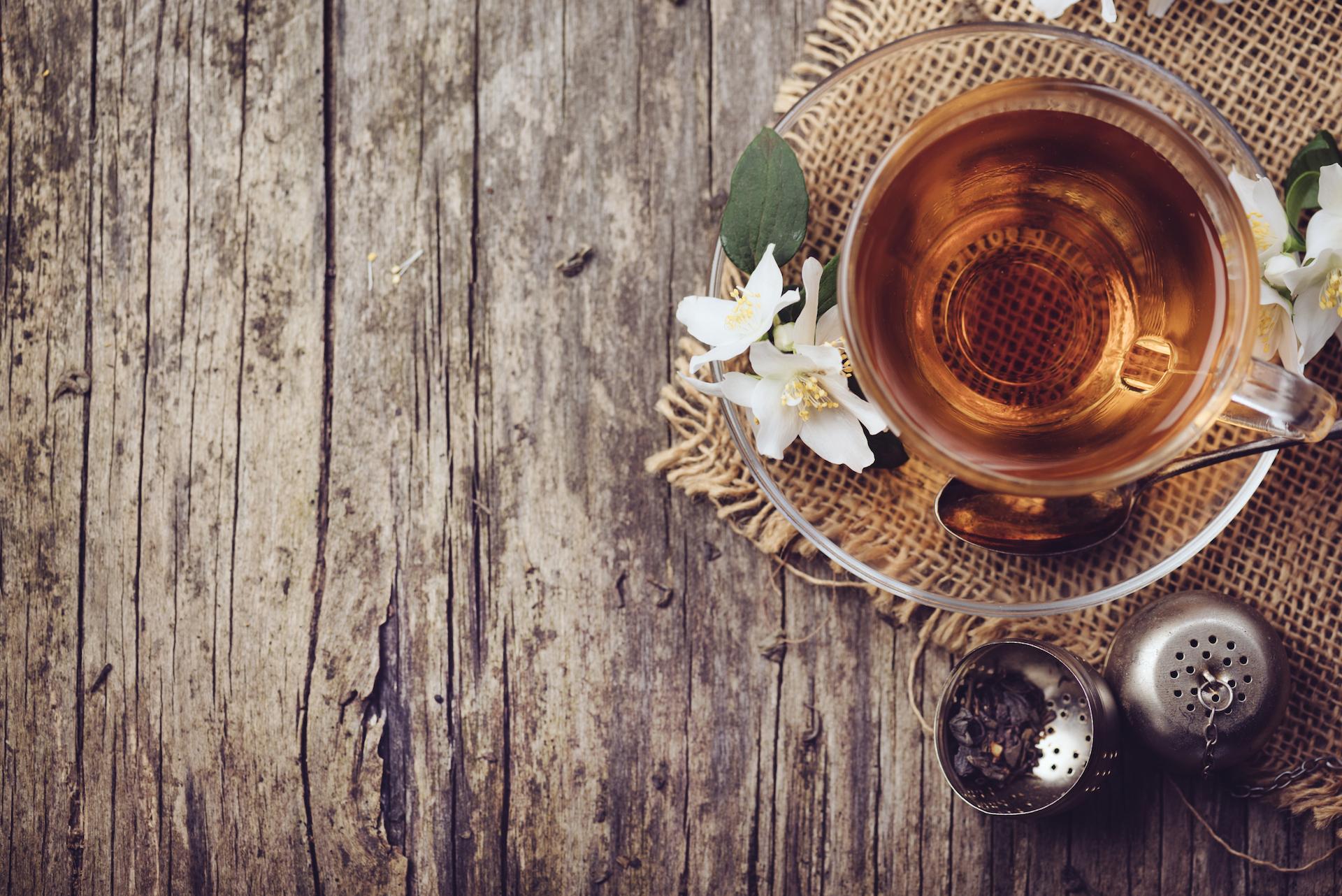What Is Jasmine Tea?
Posted by Elise Goldsworthy BHSc (Nutrition Science) on 12th Apr 2022
What exactly is jasmine tea? Where does it come from? Does it have any health benefits or risks?
Jasmine tea is a refreshing and floral tea blend with an interesting flavour. Jasmine tea is a curious creation and one that deserves a moment in the spotlight. It has a familiarity that makes it enjoyable for most tea-drinkers. Yet, it has a fragrant, almost angelic flavour profile that’s difficult to put into words. Jasmine tea comes to life as a loose leaf tea, where most quality tea-makers pride themselves by using real jasmine blossoms. It’s one to pick up in your tea-travels and savour on a quiet spring afternoon.
Typically, jasmine teas are a fusion of white or green tea leaves (camellia sinensis) with jasmine flowers (jasminum officinale). However, black or oolong varieties are occasionally used to make this reviving tea. The result is a lively, grassy, fresh-yet-floral tea blend that awakens all the senses.
Origins of Jasmine Tea
Jasmine itself is native to Middle Eastern countries, including Iran, Afghanistan and the Himalayas. However, the use of jasmine flowers to flavour tea began long ago in China. Jasmine tea is a classic Chinese tea from the Fujian tea province. Fuzhou is considered the birthplace of jasmine tea and has an ecological advantage to support its cultivation and production. The city itself is the capital of Fujian and its location and climate make it the ideal spot to produce jasmine tea. Fuzhou is flanked by mountains, which makes the area perfect for tea growing. It also rests beside a river, which helps jasmine flowers to thrive. In fact, jasmine tea production in this region is a chief source of livelihood for the local community.
Jasmine tea gained popularity during the Ming Dynasty, when flowers were seen adorning most objects owned by the Chinese aristocracy. Clothing, paintings, silverware and books were embellished with floral patterns. Jasmine flowers were a common feature and highly regarded in Chinese culture. Jasmine tea was exported and discovered by Western palates during the 1800’s. Nowadays jasmine tea is viewed as a traditional Chinese flavoured tea and enjoyed by people around the world.

How Is Jasmine Tea Made?
In some jasmine tea blends, whole jasmine flowers are used and sold within the tea. In other blends, a unique scenting process is used to infuse the tea leaves over a period of weeks to impart the sweet jasmine flavour. There are several varieties of tea scented with jasmine, each with a delicate aroma and delicious taste. Jasmine tea can be made using a traditional and contemporary method.
Traditional jasmine scented tea involves a process in which jasmine flowers are added to tea leaves to infuse them. Several changes of jasmine blossoms can be cycled to ensure a fragrant jasmine aroma is introduced. Up to 10 rounds of jasmine flowers are used in the highest quality jasmine teas. Typically, white or green tea is used to make a jasmine tea. Then, the blossoms are removed before the tea is prepared for packaging. The tea is sold as a jasmine tea infusion. In specialised jasmine teas, the jasmine blossoms are left whole in the tea mix, and packaged up ready for sale. They are graded for quality and can sometimes be sold as jasmine pearls, or jasmine balls.
The contemporary method of jasmine tea-making involves scenting the tea leaves using jasmine oil or extract. This newer method gives tea makers a larger yield at a faster production rate. The opinion among tea masters is that this modern method of tea making is inferior to the traditional method which uses fresh jasmine flowers.
Flavour & Aroma
Depending on whether you try a jasmine-infused tea, jasmine-scented tea or a tea with whole jasmine flowers, the overall flavour profile will differ slightly with each type. In general, jasmine relays a delicate, grassy and sweet aroma and pleasant tasting flavour. It is quite subtle and refreshing.
Jasmine tea can be brewed hot or made cold as an iced tea. Jasmine tea has a perfume that invokes thoughts of an afternoon reclined in your favourite chair, surrounded by walls of green gardens. Jasmine tea is relaxing and revitalising with just a hint of sweetness that puts a smile on your face.

Jasmine Tea Varieties
Green Jasmine Tea
A traditional green jasmine tea ticks all the boxes of a refreshing, slightly bitter and fragrant tea. In this loose leaf tea, the jasmine flowers are identifiable. The contrast of each ingredient pairs well, giving a verdant and lively cup of tea.
China Green Silk Pyramid Tea
For something a bit special, check out a china green jasmine loose leaf silk pyramid tea. The pyramid bag allows both the tea and jasmine flowers to unfurl and infuse your tea. You’re left with a very refreshing and uplighting flavour that’s a joy to prepare as well as drink.
Jasmine Peach Buddha Balls
If you’re someone who loves a cup of tea and a show, you’ll be sure to enjoy jasmine peach buddha balls. This tea comprises tightly curled rounds of white tea with flavours of jasmine and peach. As the tea spheres steep, they ‘bloom’ and open in a wonderful display followed by a fragrant and energising aroma.
Dublin Cream Tea
And if you’re not sure that jasmine is your thing, but you still have a sense of adventure, then this Dublin Cream Tea could be for you. This is an earthy, floral-yet-creamy tea blend worth discovering, even if just once. This jasmine flavoured tea has coffee, (yes, you read correctly), black tea and jasmine petals. It’s a bit of everything with a nod to a nip of Baileys. Somehow, it works (incredibly well!).

Health Benefits of Jasmine Tea
Jasmine has been used therapeutically in aromatherapy for various health conditions. Dermatologically, jasmine oil is used as an anti-inflammatory agent. Some species of jasmine flowers possess antiviral and antibacterial activities, which have been revealed in cell studies. There are several other touted health benefits of jasmine and jasmine tea. Here’s a few of the health advantages.
Increases Energy & Supports Weight Loss
Jasmine tea, as it’s made using camellia sinensis ‘true tea’ leaves, will have varying amounts of caffeine. Jasmine teas that are made using green or oolong teas, have a gentle effect that increases wakefulness without feeling jittery. The benefits of consuming jasmine tea are that it provides a natural boost of energy, focus and alertness. Consuming flavoured green teas, like jasmine tea can also help with boosting metabolism. This means your body can burn fat more efficiently, which helps improve other areas of health including the cardiovascular system and immune system. Your overall health and wellbeing can benefit from consuming jasmine tea.
Promotes Relaxation
The scent of jasmine tea induces a state of relaxation and calm. Jasmine has been used in aromatherapy to promote wellbeing and reduce stress. A human study investigating the calming properties of both jasmine extract and lavender found that each flower had a comparable relaxant effect in the body. Decreases in heart rate were detected amongst participants of the study. The results showed that jasmine tea fragrance had a sedative effect on the nervous system and mood. Added to this finding, the ritual of making yourself a cup of tea is also part of the therapeutic benefits of tea drinking in general. Why not make it a fragrant and refuelling cup of jasmine tea.
Anti-Cancer Properties
Jasmine tea has some intriguing therapeutic benefits in protecting against cancer cells. There is a combination of natural antioxidants found in tea, coupled with further antioxidants found in jasmine flowers. The benefits of naturally occurring epigallocatechin gallate (EGCG) in green tea has been well established in scientific literature. EGCG, which is also found in genmaicha tea, is a potent anti-cancer polyphenol. The primary action of EGCG is that it defends against oxidative damage which can impair DNA function within cells. A lab study published in 2021 found that the phenolic compounds in some jasmine plant species had powerful antioxidant activity. Some of the active constituents included kaempferol, quercetin and benzoic acid. These polyphenols, which are also found in berries, fennel and ginger, have shown anti-mutagenic and antiinflammatory effects against cancer cells.
Health Risks of Jasmine Tea
In animal studies, jasmine extract appears to reduce progesterone levels in female rates. It is also a reported emmenagogue, which means it can induce menstrual bleeding. There’s a suspected risk that jasmine oil and therefore jasmine tea can induce early labour in pregnant women and may even be associated with an increased risk of miscarriage. It’s best to avoid jasmine tea for these reasons and check with a healthcare provider if you have any concerns.
How To Brew A Fragrant Jasmine Tea
Jasmine tea can be brewed as a hot cup of tea or a refreshing, fragrant iced tea depending on your mood and the weather. Like other teas, jasmine tea can be sourced as tea bags or as a loose leaf variety. As most jasmine tea blends use white or green tea leaves, it’s important not to use just-boiled water as this can cause bitterness in your final brew.
Jasmine tea is also best enjoyed simply as is, without milk or sweeteners like honey. Nothing else is needed to fully appreciate the delicate floral flavour of your jasmine tea. Here’s how to make a wonderfully fragrant jasmine tea. For a single serve, you’ll need:
Ingredients
- 200 ml of filtered water
- 1 teaspoon of loose leaf jasmine tea
Method
- Bring water to a boil using a temperature controlled kettle or in a pot over the stove.
- Water should be heated to around 70-90 degrees celsius. If your jasmine tea blend uses black or oolong tea, the water can be brought to the boil.
- Once your desired temperature is reached, add the tea leaves including the jasmine flowers to the water.
- Steep your tea for up to 3 minutes. Jasmine tea is typically more delicate and doesn’t require a long steeping time.
- Strain your tea through a tea strainer and enjoy your fragrant and floral cup of jasmine tea.
References
El-Hawary, S. S., El-Hefnawy, H. M., Osman, S. M., El-Raey, M. A., & Mokhtar Ali, F. A. (2021). Phenolic profiling of different Jasminum Species cultivated in Egypt and their antioxidant activity. Natural product research, 35(22), 4663–4668. https://doi.org/10.1080/14786419.2019.1700508
Kuroda, K., Inoue, N., Ito, Y., Kubota, K., Sugimoto, A., Kakuda, T., & Fushiki, T. (2005). Sedative effects of the jasmine tea odor and (R)-(-)-linalool, one of its major odor components, on autonomic nerve activity and mood states. European journal of applied physiology, 95(2-3), 107–114. https://doi.org/10.1007/s00421-005-1402-8
Henning, S. M., Niu, Y., Lee, N. H., Thames, G. D., Minutti, R. R., Wang, H., Go, V. L., & Heber, D. (2004). Bioavailability and antioxidant activity of tea flavanols after consumption of green tea, black tea, or a green tea extract supplement. The American journal of clinical nutrition, 80(6), 1558–1564. https://doi.org/10.1093/ajcn/80.6.1558
https://onlinelibrary.wiley.com/doi/epdf/10.1002/art.39447
https://www.cancer.gov/about-cancer/causes-prevention/risk/diet/tea-fact-sheet
Lu, Y., Han, Z. Z., Zhang, C. G., Ye, Z., Wu, L. L., & Xu, H. (2019). Four new sesquiterpenoids with anti-inflammatory activity from the stems of Jasminum officinale. Fitoterapia, 135, 22–26. https://doi.org/10.1016/j.fitote.2019.03.029
Musial, C., Kuban-Jankowska, A., & Gorska-Ponikowska, M. (2020). Beneficial Properties of Green Tea Catechins. International journal of molecular sciences, 21(5), 1744. https://doi.org/10.3390/ijms21051744
Teerarak, M., Laosinwattana, C., & Charoenying, P. (2010). Evaluation of allelopathic, decomposition and cytogenetic activities of Jasminum officinale L. f. var. grandiflorum (L.) Kob. on bioassay plants. Bioresource technology, 101(14), 5677–5684. https://doi.org/10.1016/j.biortech.2010.02.038
Wikipedia Contributors. (2022, April 11). Jasmine. Retrieved from Wikipedia website:https://en.wikipedia.org/wiki/Jasmine, viewed April 6 2022
